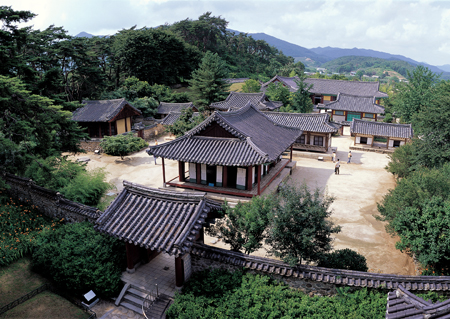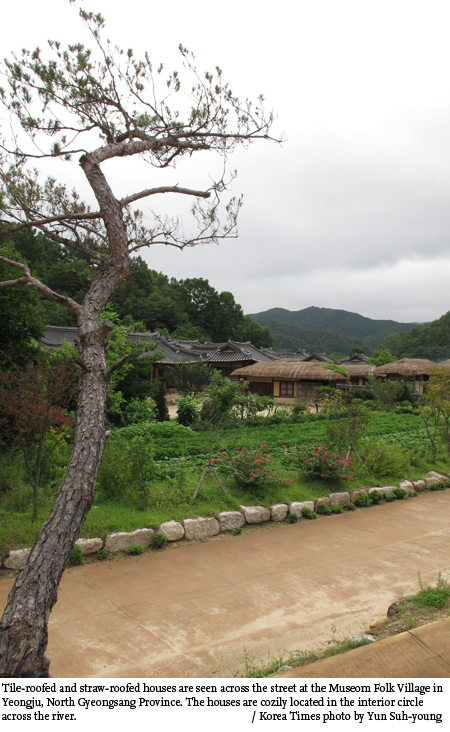
It’s hard to find students that show respect for their teachers these days.
From time to time in the news, there are reported cases of students not only verbally assaulting teachers but also physically attacking them.
In the past, this was unimaginable. Such behavior was intolerable during the “seonbi,” or scholar, culture when students were told to not even step on the shadows of their teachers.
Although the seonbi culture is no longer part of daily life in Korea, there is a place where people can still see and experience it.
Yeongju, a city located in North Gyeongsang Province, used to be home to the many seonbi who studied and refined their character at the Confucian academies.
In Yeongju, there still is a well-preserved academy in which Confucian scholars used to study. Next to the academy is a village that reenacts the lives of seonbi for visitors to experience.
Sosu Seowon
Sosu Seowon, located in the upper Yeongju City near the Sobaek mountain range, was the first Confucian academy financially supported by kings during the Joseon Kingdom.
It was established in 1542 and was later designated as the first state-approved private academy for scholars in 1549. King Myeongjong personally hand-wrote the name Sosu Seowon in a plaque to hang on the academy.
At the seowon, or academy, scholars learned and studied loyalty, filial piety, manners and knowledge.
The seowon’s architectural arrangement is quite distinguishable from other seowon because the school is located in the east and the shrine in the west, stressing greater importance on the shrine. Usually, seowon had the schools for academic learning established at the front and the shrines for memorial services in the back.
The buildings were built to differentiate its purposes. The buildings where teachers lived were positioned higher than those where students lived and studied. The teachers’ buildings were also built in front of the students’ buildings, demonstrating the Confucian culture of respecting teachers.
The site itself is perfect for taking a stroll. Surrounded by plenty of trees and graced with a pond, the seowon is a place of calm and contemplation. It is a great place to meditate and re-collect one’s thoughts.
Seonbichon
But Sosu Seowon is just a place to look around and view how the traditional schools harmonize with nature. It doesn’t offer an opportunity for visitors to go inside the buildings and experience how it feels to be seonbi.
To do that, visitors must turn their steps to Seonbichon, which is located right next to Sosu Seowon.
Seonbichon, or the scholars’ village, is a place that reenacts the living culture of seonbi. There are 12 tile-roofed and straw-roofed houses re-created for visitors’ educational experience.
The village was established in 1997 by Yeongju City to provide an educational area to foster the understanding of seonbi’s philosophy, spirit and values. The seonbi were treated as more than scholars ― they were looked upon as leaders with not only scholarly enthusiasm but also people of virtue and integrity.
The houses at Seonbichon are divided into four categories according to the character of the seonbi who used to live there. There are those who became famous, those who cultivated their morals, those who did not fear to criticize wrongdoing, and those who lived honestly despite poverty. The houses of these four different categories of seonbi are recreated at the site.
When Seonbichon closes to daytime visitors at 5 p.m., those wanting a night’s stay may lodge at the reenacted houses for a hands-on experience of traditional seonbi culture.
A standard two-person room costs 45,000 won and a luxury one 70,000 won. The four-person room starts at 70,000 won up to 140,000 won.
The site also offers various traditional recreational activities such as paper-making and dyeing fabric, riding in a cart led by a cow, calligraphy, and learning about traditional tea culture.
The commercial street has a recreated traditional market place so that visitors may buy and eat traditional food.
While walking along traditional streets, visitors may find elderly people wearing hanbok, traditional Korean costume, and playing traditional games inside the houses. When visitors walk closely toward them, elderly women often start hitting damp clothing loudly. The traditional way of ironing was to hit clothes with bats.
Museom Folk Village
Seonbichon is a recreated seonbi village, but there is a real village in which the descendents of seonbi actually live.
The Museum Folk Village is located 30 minutes away from downtown Yeongju. The village is also called Sudo-ri which means that the land is surrounded by streams so that it looks like an island floating on the water.
Around 50 traditional houses, some with tiled roofs others roofed with straw, are harmonized with nature along the stream, creating beautiful scenery.
The village holds a “single log bridge” festival every year in October and this year it will be held for two days from Oct. 13. The bridge connects the village to the land across the stream surrounding it. It was designated as one of the 100 most beautiful paths of Korea by the Ministry of Land, Transport and Maritime Affairs.
Become seonbi
A visit to these traditional sites in Yeongju will provide visitors with a chance for calm reflection, providing a serene opportunity for meditation ― something that students and bread earners may need away from their pressured lives.
People today rarely engage in this activity when seonbi used to do it habitually. <The Korea Times/Yun Suh-young>




